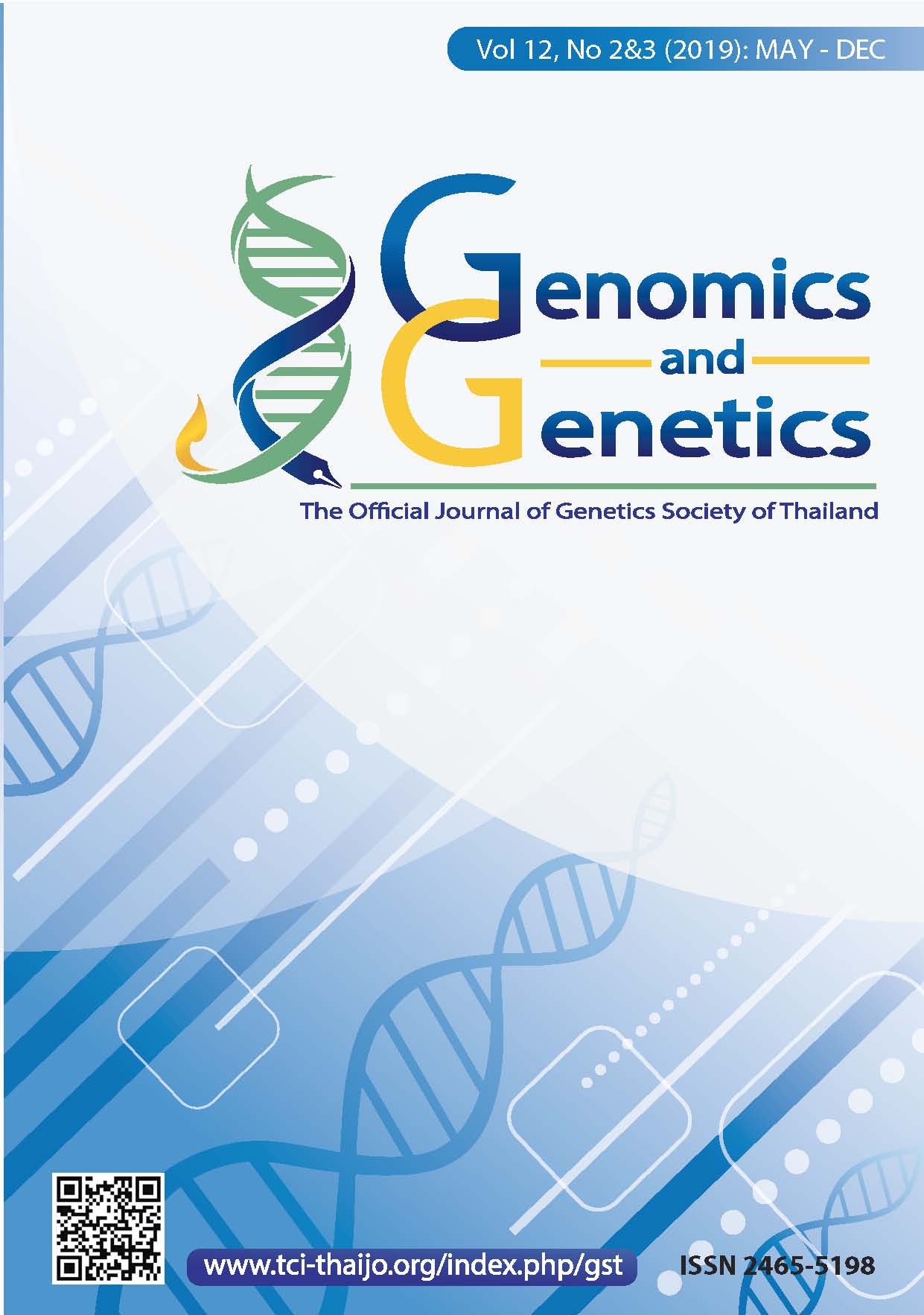Genetic and geometric analyses of Zeugodacus tau (Walker) (Diptera: Tephritidae) in the different host types
DOI:
https://doi.org/10.14456/gag.2019.5Keywords:
cucurbit fruits; Zeugodacus tau; adaptationAbstract
Zeugodacus tau (Walker), a fruit fly pest, has caused damage to fruits and cucurbit crops in Southeast Asia including Thailand. Different cucurbit fruits have some unique characteristics that directly or indirectly influence the fruit fly pest. To investigate either adaptation or specification of Z. tau to different fruit types, genetic and geometric analyses were used for verification. The Cytochrome Oxidase I haplotypes of Z. tau collected from three cucurbit fruit species, luffa (Luffa aegyptiaca), bitter gourd (Momordica charantia) and winter melon (Benincasa hispida) were examined by Single Strand Conformation Polymorphism analysis. Nine distinct haplotypes (A, B, C, D, E, F, G, H and I) were found. The unique haplotypes were detected in Z. tau population from luffa (haplotypes E, F and H) at very low levels, while haplotypes C and D were presented in all populations at higher levels. Moreover, mean haplotype diversities were high for all populations expected to relate with gene flow among populations. The analysis of molecular variance (AMOVA) also revealed low FST value (0.085) of the genetic differences among Z. tau populations from different fruit types suggesting that Z. tau can move freely among host plants. In contrast, the morphological differences in Z. tau associated with host fruit species were investigated by geometric analysis based on 13 wing landmarks. The differences were described by the two discriminant factors (male: DF1 = 53% and DF2 = 47%, female: DF1 = 64% and DF2 = 36%). The differences in wing morphology of Z. tau from each populations indicated that fruit species play an important role during larval adaptation of phytophagous insects.
References
Areekul S (1986) Toxicity tests of some insecticides against fruit flies II Dacus cucurbitae Coquillet and Dacus tau (Walker). Kasetsart Journal. 3(20): 274–279.
Baimai V, Phinchongsakuldit J, Sumrandee C, Tigvattananont S (2000) Cytological evidence for a complex of species within the taxon Bactrocera tau (Diptera: Tephritidae) in Thailand. Biological Journal of the Linnean Society. 69(3): 399–409.
Boopathi T, Singh SB, Manju T, Chowdhury S, Singh AR, Dutta SK, Dayal V, Behere GT, Ngachan SV, Hazarika S, Rahman SMA (2017) First report of economic injury to tomato due to Zeugodacus tau (Diptera: Tephritidae): relative abundance and effects of cultivar and season on injury. Florida Entomologist. 100(1): 63–69.
Bush GL (1969) Sympatric host race formation and speciation in fruigivorous flies of the Genus Rhagoletis (Diptera, Tephritidae). Evolution. 23(2): 237–251.
Choudhary, JS, Naaz N, Prabhakar CS, Lemtur M (2016) Genetic analysis of oriental fruit fly, Bactrocera dorsalis (Diptera: Tephritidae) populations based on mitochondrial cox1and nad1 gene sequences from India and other Asian countries. Genetica. 144(5): 611–623.
Christenson LD, Foote RH (1960) The biology of fruit flies. Annual Review of Entomology. 5(1): 171–192.
Clarke AR, Armstrong KF, Carmichael AE, Milne JR, Raghu S, Roderick GK, Yeates DK (2005) Invasive phytophagous pests arising through a recent tropical evolutionary radiation: the Bactrocera dorsalis complex of fruit flies. Annual Review of Entomology. 50: 293–319.
Cockburn AF, Fritz GA (1996) Isolation and purification of insect DNA. In: Clapp, J.P. (eds) Species Diagnostics Protocols: PCR and Other Nucleic acid Methods (pp 15–23). New Jersey: Humana Press, Totowa.
Excoffier L, Lischer HE (2010) Arlequin suite ver 3.5: a new series of programs to perform population genetics analyses under Linux and Windows. Molecular Ecology Resources. 10(3): 564–567.
Fontaine C, Thébault E (2015) Comparing the conservatism of ecological interactions in plant–pollinator and plant–herbivore networks. Population Ecology. 57(1): 29–36.
Friberg M, Wiklund C (2009) Host plant preference and performance of the sibling species of butterflies Leptidea sinapis and Leptidea reali: a test of the trade-off hypothesis for food specialisation. Oecologia. 159(1): 127–37.
Kitthawee S, Dujardin JP (2010) The geomatric approach to explore the Bactrocera tau complex (Diptera: Tephritidae) in Thailand. Zoology . 113(4): 243–249.
Kunprom C, Sopaladawan PN, Pramual P (2015) Population genetics and demographic history of guava fruit fly Bactrocera correcta (Diptera: Tephritidae) in northeastern Thailand. European Journal of Entomology. 112(2): 227–234.
Nimmakayala P, Saminathan T, Abburi VL, Yadav LK, Tomason Y, Levi A, Weng Y, Reddy UK (2017) Comparative genomics of the Cucurbitaceae. In: Grumet, R. et al. (eds) Genetics and Genomics of Cucurbitaceae, Plant Genetics and Genomics: Crops and Models. New York: Springer Intl Pub AG.
Shi W, Yang T, Ye H, Cao J (2017) Impact of host plants on genetic variation in the Bactrocera tau (Diptera: Tephritidae) based on molecular markers. Journal of Entomological Science. 52(4): 411–426.
Singh SK, Kumar D, Ramamurthy VV (2010) Biology of Bactrocera (Zeugodacus) tau (Walker) (Diptera: Tephritidae). Entomological Research. 40(5): 259–263.
Somsill P, Julsirikul, D, Rakthong P, Kitthawee S (2015) Morphology and genetic diversity of the Bactrocera tau complex in southern Thailand. Rajabhat Journal of Sciences, Humanities & Social Sciences. 16(2): 334–346.
Uchôa MA (2012) Fruit flies (Diptera: Tephritoidea): Biology, host plants, natural enemies, and the implications to their natural control. In: Larramendy, M.L. and Soloneski, S. (eds) Integrated Pest Management and Pest Control Current and Future Tactics (pp 271–300). Rijeka, Croatia: InTech.
Yong HS, Song SL, Lim PE, Eamsobhana P (2017) Complete mitochondrial genome of Zeugodacus tau (Insecta: Tephritidae) and differentiation of Z. tau species complex by mitochondrial cytochrome c oxidase subunit I gene. PLoS ONE. 12(12): e0189325.
White IM, Elson-Harris MM (1992) Fruit Flies of Economic Significance: Their Identification and Bionomics. United Kingdom: Centre for Agriculture and Biosciences International.



